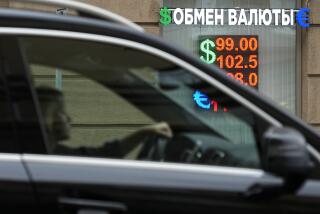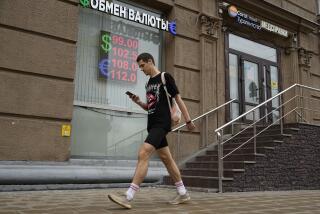Russia’s Old Kopeck Makes a Comeback
- Share via
MOSCOW — Long gone but not forgotten, the humble kopeck returned to Russia on New Year’s Day to cheer a population distressed by mind-boggling bank notes that made every loaf of bread seem staggeringly expensive.
The welcome return of the denomination that is one-hundredth of a ruble is part of the Russian currency reform that, as of Thursday, lops off three zeros from the inflation-battered ruble.
The gradual exchange of old notes for new ones also serves as a government declaration of victory over inflation, which fell to a modest 11% in 1997 after reaching annual four-digit levels in 1992-94.
New bank notes and coins will circulate with the old currency for the rest of this year, and prices likewise will be posted throughout 1998 in both old and new rubles.
The new currency system has been two years in the making, and a government-funded public relations blitz after President Boris N. Yeltsin’s announcement of the change in August appears to have smoothed over most worries that buying power or bank savings would be depleted.
A poll by the independent Public Opinion agency indicates that at least 60% of 1,500 consumers questioned last month had a positive attitude toward the new currency.
Introduction of the new system at the start of a four-day holiday weekend also has headed off any panic. Banks are closed until Monday and few, if any, of the open stores had been supplied with new rubles ahead of the change. Cash machines and currency-exchange booths also continued to spill out old rubles.
But the new pricing system coinciding with the currency change had an immediate psychological effect by making the cost of products easier to calculate.
“The return of the kopeck rekindles sentiments from the Soviet times, when it was possible to buy something with any amount of money,” effused Irina Bavrina, a 59-year-old dental technician. “Even if you had only one kopeck, you could buy a box of matches.”
As inflation caused by the government’s reckless printing of money in the early 1990s ravaged the Russian currency, the state mint introduced larger and larger ruble denominations. The biggest old note in circulation is the 500,000-ruble bill, worth about $84, and the value of the smallest--100 old rubles--is so minimal at about 1.7 cents that many shops and services had been refusing to accept it. In the Soviet era, 100 rubles was worth $160.
“I’m kind of excited about the new money,” said 83-year-old pensioner Mariya Basheva. “It is like going back to a time when I was young and enjoyed the sound of kopecks tinkling in my purse. Then, to have a whole ruble made you feel rich.”
Like many Russians, she expressed worry that the simultaneous use of old and new bills will be confusing. For example, a product costing 30 new rubles ($5.04) can be bought with a combination of one old 5,000 bill, five new singles, an old 10,000 and a new 10.
“If it gets confusing, we’ll just make people pay either with all new rubles or all old ones,” said an indifferent kiosk clerk selling dairy products at the Dobrininskaya subway station, validating popular fears that the currency reform at least will be inconvenient.
Two previous ruble “reforms” were carried out with disastrous consequences. In 1991, the government declared all 50- and 100-ruble bank notes invalid, destroying the cash savings of millions of bank-wary Russians. Two years later, the government gave citizens only three days to exchange old rubles for new ones, triggering widespread panic and long lines at banks.
But Yeltsin’s economic aides have spent months preparing the public for this currency swap, with radio jingles, celebrity endorsements and a dual-pricing scheme that took effect a month ahead of the change. A liter of apple juice on sale at one kiosk, for example, was marked at 5,800 old rubles and at 5 new rubles and 80 kopecks--about 97 cents by either measure.
Inflation’s progressive devaluation of the old money made the kopeck an anachronism, except for its importance to the country’s verbal culture. The Russian language has produced expressions about the kopeck that are almost exact equivalents of “a penny saved is a penny earned,” “without a penny to his name” and “penny-wise and pound foolish.” Yet no kopecks have been in circulation for the past five years, and young children are perplexed by the folkloric references.
Coin-operated turnstiles for the Moscow Metro’s 160 subway stations were converted to tokens four years ago, as were public phone booths. Despite the currency reform and the taming of inflation, transportation and communications authorities said they have no immediate plans to retool their turnstiles and phones to again accept coins.
The permanent inroads made by inflation are obvious in the cost of the zhitoni tokens for a ride on the Metro or a phone call--both now 2,000 old rubles or two new ones (about 34 cents). Throughout the Soviet era, Metro passage cost less than 8 cents and telephone calls were 3 cents.
“What if inflation comes back and makes all this new money worthless again?” worried Marina Kamenskaya, a 49-year-old school administrator. She said she feared higher prices as retailers would be encouraged to round up to the nearest full ruble.
But such assumptions illustrate a lack of understanding about market economics, journalist Boris Zhukov wrote in this week’s edition of the newsmagazine Itogi. “It does not occur to many people that sellers and producers can raise prices whenever they want,” Zhukov wrote, noting that competition discourages unjustified boosts.
Central Bank authorities hope to remove as much as 90% of the old currency in the first quarter of this year, but they have emphasized there is no need to rush.
Final judgment on the success of the currency reform will take months, as Russia’s economy is still wobbly from the global stock crisis of autumn and a hefty budget deficit caused by poor tax collection and slow investment.
“Nothing unexpected will happen,” Prime Minister Viktor S. Chernomyrdin assured Russians in a message delivered on New Year’s Eve, reminding people that banks will exchange old rubles any time over the next five years.
More to Read
Sign up for Essential California
The most important California stories and recommendations in your inbox every morning.
You may occasionally receive promotional content from the Los Angeles Times.











